"A spoonful of sugar helps the medicine go down, |
SucroseTable sugar
Paul May
Also available: HTML version.
|
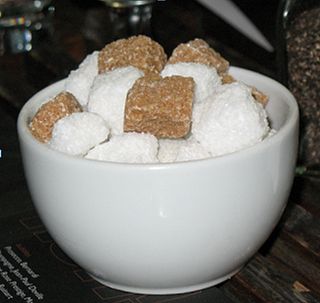 |
"A spoonful of sugar helps the medicine go down, |
SucroseTable sugar
Paul May
Also available: HTML version.
|
 |
Sucrose is ‘table sugar’. Its name comes from the Greek word for sugar (sucrum). It might be odd to think now, but until about 200 years ago sugar was very rare in the Western world. It was so rare that it was considered to be a very valuable luxury.
 So how was food sweetened?
So how was food sweetened?People usually added honey, but this doesn’t work well for baking, and it’s messy to add to drinks like coffee or tea. Once sugar became available, and people found out how useful, convenient and tasty it was, the demand grew hugely. Within a few years in the late 1700’s it had gone from being a luxury to an essential food item. In the US, frontier families used sugar to make jams, jellies and preserves to keep them alive in the period from summer harvest through the harsh winters to the ‘starving time’ before the first harvest. Sugar is also an essential ingredient in manufacturing of alcohol, which is why many famous breweries were founded in the 18th & early 19th centuries. Indeed, in the 19th century some workmen were partly paid in alcohol allowance rather than cash. It could be argued that sugar was so influential it changed the course of world history.
Sugar cane grows best in hot, humid climates, such as the islands in the Caribbean, so from the beginning of the 18th Century a race began among European countries to colonise these areas as fast as possible, and set up sugar plantations. A supply of cheap labour was needed, and this fuelled the slave trade from Africa to work on sugar plantations and in sugar refineries. In the West, millions of slaves were shipped from Africa to the West Indies and Southern States of the USA, while in the East indentured labourers, mostly from India, were taken to East Africa and Southeast Asia. Sugar was so valuable that wars were fought over access to Caribbean islands and piracy was rife. The standard drink of the Royal Navy (and of pirates) used to be rum, made from distillation of sugarcane juice or its byproducts, such as molasses. It’s been said that much of the wealth of the early British Empire came from its sugar plantations, and that this money helped bankroll the Napoleonic Wars against the French, as well as pay for many of the scientific and engineering advances that led to the Industrial Revolution. The slave trade changed the population demographics of many parts of the world. Even nowadays, it can be said that the varied mix of ethnicities and nationalities found in most modern countries can be traced back to the upheavals brought about by global trade in sugar (with help from other goods such as tobacco and cotton, of course).
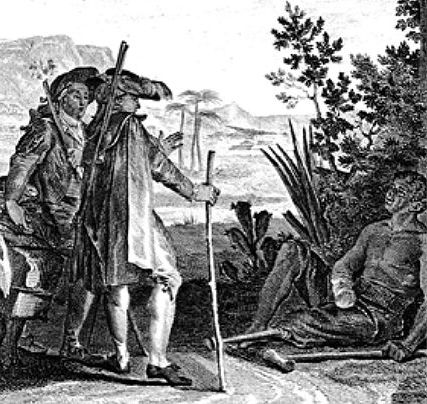 |
 |
This is a 1787 engraving from Voltaire's Candide depicting the scene where Candide and Cacambo meet a maimed slave of a sugar mill near Surinam. The slave has had his hand chopped off for getting his finger caught in a millstone and his leg removed for attempting to escape. The caption is the slave saying, "It is at this price that you eat sugar in Europe." |
Pirates often sailed around the Caribbean, looking to plunder the rich ships of their sugar cargoes – although not many pirates looked like Jonny Depp! |
The term ‘sugar’ refers to a class of molecules called saccharides. Monosaccharides, such as glucose contain only one sugar unit per molecule; disaccharides contain 2 sugar units bonded together, such as in sucrose; and polysaccharides are polymers containing many sugar units, as in cellulose or starch (see MOTM on Glucose).
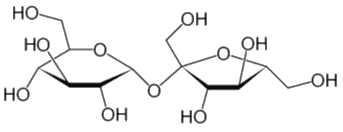
Sucrose is made from joining glucose, a 6-membered ring sugar (left), to fructose, a 5-membered ring sugar (right).
Yes, it’s composed of two smaller sugars bonded together, in this case glucose and fructose, linked via an ether bond.
Both glucose and fructose are used independently as sweeteners in food, too. But the economic reason is because the sugar-rich crops (sugarbeet and sugarcane) contain 10-20 times more sucrose than either glucose or fructose, so sucrose is easier to extract and purify. It also turns out that the absorption of both of these sugars from the intestine into the bloodstream is significantly enhanced if they are ingested in equal amounts. And in sucrose they are in exactly the correct 1:1 ratio.
In the past, efficiently and quickly metabolising food into energy might make the difference between successfully running away from danger and being eaten ourselves! But nowadays, of course, it’s becoming a huge problem (no pun intended). Sugar is now so commonplace, and eaten so often, that obesity levels are rising all over the modern world, bringing with it associated problems of heart disease and diabetes (see MOTM on Insulin).
 | 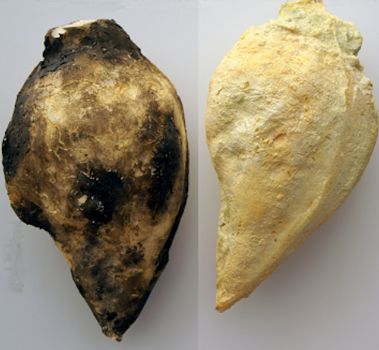 |
The two main sources of table sugar are sugarcane... | ...and sugarbeet, after harvesting (left) and cleaning (right). |
Lots of exercise and a carefully controlled diet help, especially cutting down on sugar intake. One of the best ways to do this is to use artificial sugar substitutes, rather than sugar.
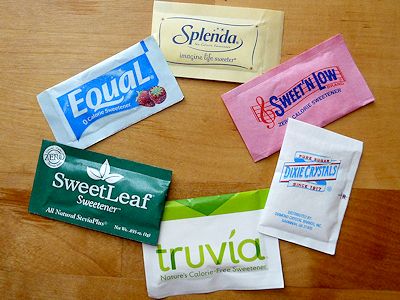 There are a number of sugar substitutes, or artificial sweeteners on the market, the most popular are saccharin, aspartame, sucralose, and cyclamate. Many of these were discovered by accident, usually by a chemist doing something they’re never supposed to do in a chemistry lab – lick their fingers! In the case of sodium cyclamate, the graduate student had put his cigarette on the side of the lab bench (yes, you were allowed to smoke in chemistry labs in 1937!), and when he put it back in his mouth it tasted sweet. The advantage of these artificial sweeteners comes from the fact that they are often many times as sweet as sucrose, which means you don’t need to use very much of them, and also that they are not metabolised in the same way as sugar, so you don’t get fat. They also don’t cause tooth decay.
There are a number of sugar substitutes, or artificial sweeteners on the market, the most popular are saccharin, aspartame, sucralose, and cyclamate. Many of these were discovered by accident, usually by a chemist doing something they’re never supposed to do in a chemistry lab – lick their fingers! In the case of sodium cyclamate, the graduate student had put his cigarette on the side of the lab bench (yes, you were allowed to smoke in chemistry labs in 1937!), and when he put it back in his mouth it tasted sweet. The advantage of these artificial sweeteners comes from the fact that they are often many times as sweet as sucrose, which means you don’t need to use very much of them, and also that they are not metabolised in the same way as sugar, so you don’t get fat. They also don’t cause tooth decay.
Yes, although the links are not completely established yet. But there’s a growing medical opinion that sugar combined with cholesterol may be implicated. Sugar, and in particular, glucose, which is the monosaccharide half of sucrose, is actually slightly toxic. The body puts up with this toxicity because glucose is so useful because it’s such a concentrated source of high energy. Indeed, if sugar is removed from the diet completely, some bodily functions, particularly those in the brain (like memory, attentiveness and cognitive skills) become impaired. However, if the body ingests too much glucose, more than the insulin in the bloodstream (see MOTM on insulin) can remove easily, then the toxic effects can occur. These usually take the form of inflammation in the blood vessels and arteries. The body’s natural response to an inflammation is to send cells to kill any infection (if there is any), along with other molecules – in this case cholesterol - to patch up the damage (see MOTM on cholesterol). However, if the blood-vessel walls are continually having to be ‘patched up’ with ‘sticking plasters’ of cholesterol, we get patches on top of patches, and this leads to a blockage in the blood vessel, and then heart problems. So it appears that a high level of cholesterol alone is not the big problem – it’s high levels of cholesterol plus high levels of sugar that’s the killer. And if you look at how the Western diet has changed over the last 100 years – the number of foodstuffs that contain lots of fat (cholesterol) and lots of sugar (sucrose) has increased hugely – along with heart disease.
 |
 |
 |
![]()
![]()